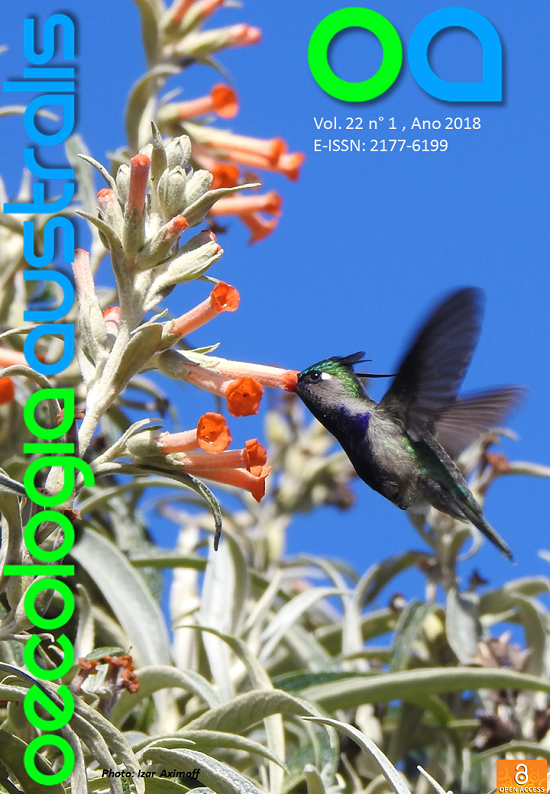INTERAÇÕES ENTRE PLANTAS E POLINIZADORES SOB UMA PERSPECTIVA TEMPORAL
DOI:
https://doi.org/10.4257/oeco.2018.2201.01Palavras-chave:
escalas temporais, fenologia de floração, insetos, redes de interação, sazonalidadeResumo
O sucesso da polinização biótica depende da sincronização dos períodos de floração e da atividade dos polinizadores. O objetivo desta revisão foi compilar e analisar publicações abordando os principais efeitos da dinâmica temporal nas interações entre plantas e polinizadores em diferentes escalas, incluindo variações diárias, mensais, entre estações e entre anos. Fatores como período, intensidade e tempo de floração influenciam as interações planta-polinizadores e podem constituir estratégias para otimizar a atratividade e/ou diminuir a concorrência por polinizadores e, consequentemente, aumentar o sucesso reprodutivo. Estudos sobre polinizadores, principalmente insetos, concentram-se na sazonalidade ao longo do ano, principalmente apresentando variações e maior atividade de polinizadores na estação chuvosa. Tais variações podem ocorrer de acordo com as características dos ciclos biológicos das espécies, bem como em resposta à disponibilidade de recursos e variáveis climáticas. Importantes propriedades estruturais das redes de interações plantas-polinizadores, tais como aninhamento e conectância, permanecem constantes ao longo dos anos. Apesar disso, mudanças na composição e riqueza de espécies de plantas e polinizadores entre os anos alteram o número e a configuração das interações entre eles. Este fato sugere que a estrutura das redes de interação e a funcionalidade do sistema de polinização podem ser mantidas ao longo do tempo independente da composição das espécies e do arranjo entre elas. Estudos futuros devem investigar as causas das variações temporais nas interações entre plantas e polinizadores, principalmente as que podem estar relacionadas a alterações antrópicas, a fim de apontar ações que minimizem o impacto humano.
INTERACTIONS BETWEEN PLANTS AND POLLINATORS IN A TEMPORAL PERSPECTIVE. The success of biotic pollination depends on the synchronization of flowering periods and activity of the pollinators. This review aimed to compile and analyze publications addressing the main effects of temporal dynamics on plant-pollinator interactions at different scales. Factors such as period, intensity, and flowering timing influence plant-pollinator interactions. These may constitute strategies to optimize attractiveness and/or decrease of the competition for pollinators, consequently enhancing reproductive success. Studies on pollinators, mostly insects, focus on the seasonality throughout the year, mainly showing variations and increased activity of pollinators in the rainy season. Such variations can occur according to the characteristics of the biological cycles of the species, as well as in response to the availability of resources and climatic variables. Important structural properties of the plant-pollinator networks such as nestedness and conectance remain constant over the years. Despite this changes in the composition and richness of pollinator and plant species occur between years and alter the number and configuration of the links between them. This suggests that the structure of the pollination networks may be independent of species composition and the arrangement between them and the functionality of the pollination system can be maintained over time. Future research should investigate the causes of temporal variations in interactions between plants and pollinators. Especially those related to anthropic alterations aiming identify actions that can minimize human impact.


